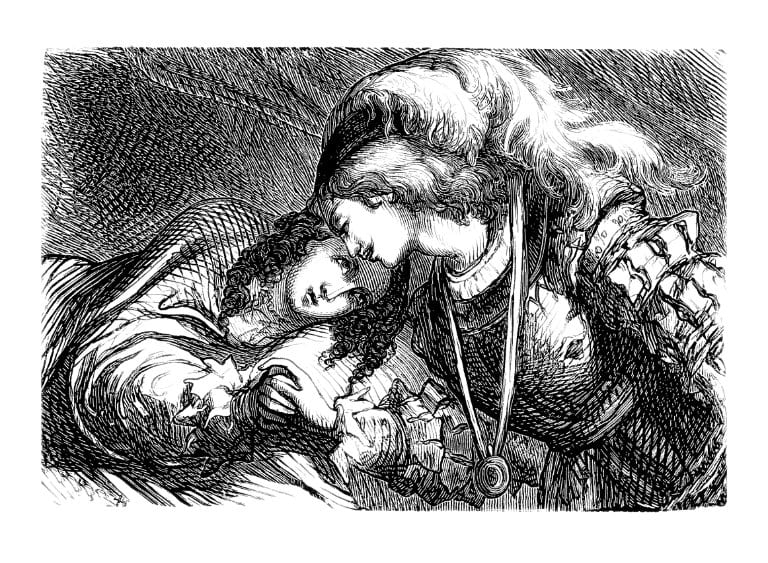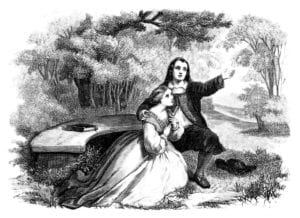‘Romeo and Juliet’ (1595)
The Prologue to ‘Romeo and Juliet’ takes the radical step of summarising the whole story before the play begins, meaning that the audience knows from the start how it will end: ‘A pair of star-cross’d lovers take their life’. So throughout the ‘two hours’ traffic’ there is no hoping for a happy ending, since the young lovers’ efforts to secure their future will be in vain.
It is interesting to speculate on Shakespeare’s motives here: is it possible that he decided to open his play with a summary of the narrative specifically so as to avoid disappointing his audience? Was the Prologue a late addition to the play, after testing initial audience reaction? Had audiences been drawn to the play in the expectation of a happy ending, only to experience the crushing disappointment of – spoiler alert – the death of both principals?
Shakespeare’s Only Children
Was Juliet an only child? Is this what her father Capulet means when he tells her suitor Paris that ‘The earth hath swallow’d all my hopes but she?’ And is this why she seems so isolated when Romeo is banished?
Only children seem to be legion in Shakespeare’s plays. Romeo himself seems to be one such, along with characters like Rosalind (‘As You Like It’), Helena (‘All’s Well’) and Jessica (‘The Merchant of Venice’).
The Late Plays also seem to be full of only children – daughters in particular – including Marina in ‘Pericles’, Perdita in ‘The Winter’s Tale’, Imogen in ‘Cymbeline’ and Miranda in ‘The Tempest’.
Shakespeare himself (as mentioned earlier) was the oldest of six surviving children, and after the death of his son Hamnet, father to two daughters.
‘The Merchant of Venice’ (1595)
It was famously prohibited for female actors to perform on the Elizabethan / Jacobean stage, so we may imagine Shakespeare developing female characters designed to be played by men – or perhaps boys.
This includes such formidable figures as Lady Macbeth, Cleopatra and Goneril and Regan, alongside a host of others.
Shakespeare’s challenge to this embargo is to routinely dress his female characters as males (Portia, Rosalind, Viola, Imogen, Silvia) and invest them with stronger personalities than many of their male counterparts. For example the trial in ‘The Merchant of Venice’ proves intractable to resolve until the appearance of the lucid Balthazar, played by Portia.
Transfers of Power
Around a half of all Shakespeare’s plays are concerned with transfers of power in one way or another. It goes without saying that the History plays explore this theme, from ‘Richard II’ (a king deposed) to ‘Henry IV’ (with his unsuitable heir) to ‘Henry VI’ (a lost civil war).
The Roman plays are similarly preoccupied with power and who holds it, from ‘Julius Caesar’ (murdered in the Senate) to ‘Antony and Cleopatra’ (defeated in battle), not forgetting ‘Titus Andronicus’, a Shakespearean anticipation of Quentin Tarantino. Elsewhere, power is seized by murder (‘Hamlet’) or deceit (‘The Tempest’) – or simply for its own sake (‘As You Like It’, ‘King Lear’ and ‘Othello’).
In Shakespeare’s lifetime, discussions about the succession was not, of course, confined to the theatre, though after Pope Pius V issued Regnans in Excelsis in 1570, excommunicating Elizabeth I, conversations about changes of monarch were potentially highly-charged and perilous exchanges.
Addressing Servants in Shakespeare’s Plays
The word ‘sirrah’ appears 146 times in Shakespeare’s plays – six times in ‘Romeo and Juliet’ for example, eleven times in ‘Henry IV’ Part One. It’s a routine form of address, familiar to Shakespearean audiences.
The word has dropped out of modern English altogether, and perhaps that is no bad thing, since it is a condescending way of capturing the attention of someone of lower status. In ‘Henry IV’ Part One for example, it is used six times by Prince Hal, but not once is it employed in his direction. Of its six appearances in ‘Romeo and Juliet’, five are by Capulet, mostly to address servants.
Ghosts in Shakespeare’s Plays
Ghosts may have been seen as relics of Catholic superstition by Shakespeare’s Protestant contemporaries, but to Shakespeare himself they were a powerful dramatic instrument, and he uses them in five of his plays.
In ‘Hamlet’ the appearance of the ghost of Hamlet’s father in the opening act is the trigger for much of what follows – including his reappearance in Act Three when Hamlet is alone with Gertrude. In ‘Julius Caesar’ the ghost of the murdered general appears to Brutus on two separate occasions, while in ‘Richard III’, ghosts of ten of his victims appear to the tyrant on the eve of Bosworth. In ‘Cymbeline’, ghosts of Posthumus’s family plead with Jupiter for him to be spared execution: successfully, as it turns out.
Only the ghost of Banquo, arriving late for the feast being held in his honour, is silent – though his ‘blood-bolter’d’ appearance is perhaps eloquent enough.
Rhyme, Verse and Prose in the 1590s
The evidence suggests that as a young playwright in the early 1590s, Shakespeare’s instincts dictated that plays should be written in verse. But the proportion of verse to prose in his plays declines as his career as a dramatist progresses through the decade.
Initially in the ‘Henry VI’ plays (c. 1591) there is no prose at all, apart from the speeches by the rabble-rousing Jack Cade in Part Two. ‘Love’s Labour’s Lost’, written in around 1594 is written almost entirely in verse, of which around two-thirds is rhymed.
The only play that approaches this figure is ‘A Midsummer Night’s Dream’, just over half of which is rhymed. By contrast, ‘The Merry Wives of Windsor’ (1600) is 87% prose, a striking contrast with ‘Titus Andronicus’ (1590) at 1%.
The Weather in Shakespeare
Meteorological conditions play a discreet but significant role in Shakespeare’s plays. In ‘Macbeth’ the weather is foregrounded, not only in Macbeth’s observation early in the play that the day is at once both ‘fair and foul’, but also in the sun’s weakness after Duncan’s murder, as ‘dark night strangles the travelling lamp’.
Stormier weather in ‘King Lear’ – reflecting the former monarch’s turmoil – and in ‘Julius Caesar’, anticipating Caesar’s assassination, are further examples of Shakespeare’s use of the pathetic fallacy. Owen Glendower has his own meteorological story to tell in ‘Henry IV Part One’, where he claims that ‘at my nativity / The front of heaven was full of fiery shapes’ – an improbable account which Hotspur dismisses: ‘I’ll to dinner’, he replies.
Perhaps the most significant of these natural phenomena is actually man-made: the storm brewed up by Prospero with which ‘The Tempest’ (like ‘Pericles’ and ‘Twelfth Night’) gets underway.
Death of Hamnet Shakespeare (1596)
Hamnet was born in 1585, Judith’s twin, and a younger brother for Susanna. From the age of around five, with his father three days’ travel away in London, it is likely that the boy saw little of Shakespeare before his death in 1596, aged 11.
It is unwise to draw firm connections between the life of the writer and his work, but Shakespeare’s plays sport several examples of young men believed lost being recovered. In ‘Twelfth Night’ for example, Viola believes her twin brother Sebastian has been drowned, but he reappears in Act Four, alive and well. Similarly, Alonso in ‘The Tempest’ struggles to come to terms with Ferdinand’s drowning, only to discover that his son is alive and well, and engaged to be married to Miranda.
Wish fulfilment on the playwright’s part, perhaps.
Shakespeare’s Medics
Members of the medical profession play a modest role in Shakespeare’s plays. Some have their origins in real life, like Sir William Butts, physician to Henry VIII, who appears in the play of that name, and Dr John Caius, Elizabeth I’s doctor, who is parodied in ‘The Merry Wives of Windsor’ as a quack.
Elsewhere we encounter the fictional Cornelius (in ‘Cymbeline’) and Cerimon (in ‘Pericles’), not to mention Dr Pinch in ‘The Comedy of Errors’. Most memorable, perhaps, is Helena in ‘All’s Well That Ends Well’, trained in medical matters by her late father, now employing her skills to great effect.
Perhaps the best-known medic in Shakespeare, however, is the doctor who does no more than watch the sleep-walking Lady Macbeth as she revisits a litany of crimes confused in her subconscious. ‘More needs she the divine than the physician’, he observes, before making his exit.
Shakespeare’s older daughter Susanna married a doctor in 1607.
Shakespeare’s Late-Elizabethan Comedies
Female actors were famously banned from the stage in Shakespeare’s day. Nevertheless, a number of his late-Elizabethan comedies offer leading roles to two prominent female characters. For example, ‘Much Ado About Nothing’ (1598) has Beatrice and Hero, ‘As You Like It’ (1599) has Rosalind and Celia, ‘Twelfth Night’ (1599) has Olivia and Viola and ‘All’s Well That Ends Well’ (1602) has Helena and the Countess.
There may be a rather mundane explanation for this pattern – namely that around this time, the Lord Chamberlain’s Men had two particularly strong young male actors, capable of delivering complex and demanding roles like these. The strength and depth of the characters they were lined up to play may suggest that Shakespeare had his own views about the embargo on female actors.
Shakespeare and the Welsh
Shakespeare presents a somewhat ambiguous picture of England’s closest neighbour to the west of Offa’s Dyke. In ‘Henry IV Part One’ (c 1597), the Welsh prince Owen Glendower is presented as self-important and ultimately untrustworthy: even his ally Hotspur treats him with a certain contempt, though his daughter, the monolingual Welsh-speaking wife of the Earl of March, is presented respectfully.
Elsewhere in Shakespeare’s plays, stereotypes abound: Sir Hugh Evans, the Welsh parson and schoolmaster in ‘The Merry Wives of Windsor’, is a long-winded gossip, while Fluellen in ‘Henry V’, though brave and loyal, is similarly presented as comically keen on the sound of his own voice.
It is worth remembering that these representations, though in many ways affectionate, are less than respectful to the home of the country’s ruling Tudor dynasty.
Gender Roles in Shakespeare’s Romances
Romance in Shakespeare does not always reflect what might be considered traditional gender roles. Often it is the female character who makes the eyes.
For example, in ‘As You Like It’, Rosalind takes the leading role in her romance with Orlando, and in ‘The Merchant of Venice’, Portia is the dominant partner in her romance with Bassanio. It’s fair to say that Juliet is just as fervent (and forward) as Romeo when they fall in love with one another,
Perhaps the most enthusiastic of Shakespeare’s female lovers is Venus in ‘Venus and Adonis’, the 1200-line poem he composed during the 1593 plague lockdown. Here the Goddess of Love romances the God of Beauty, and is rebuffed – with fatal consequences for the reluctant male.
‘A Midsummer Night’s Dream’ (1596)
Audiences wondering why there are over fifty references to the moon in ‘A Midsummer Night’s Dream’ – including ‘moonshine’, ‘moonbeams’, ‘moonlight’ etc. – might bear in mind the circumstances in which the play was produced: a play set at night but necessarily performed (in Shakespeare’s era) during daylight.
Thus the repeated references to the moon (‘The moon, methinks, looks with a watery eye’ observes Titania in Act III) serve to remind the mid-afternoon audience that the events they are witnessing take place (as the title implies) at night.
Later in his career, once the Blackfriars Theatre was ready for the King’s Men to use in 1609, such expedients were less urgent.
‘William the Conqueror’
The story goes that Richard Burbage, the incomparable actor who first played the parts of Romeo, Hamlet and Othello, was performing in the title role of ‘Richard III’ when he attracted the attention of a young woman, who arranged for him to visit her after his performance was over. On arrival, Burbage was to announce himself to her servants as Richard III.
Shakespeare seems to have overheard these arrangements being made, and stolen a march on his friend by visiting the address himself while the play was in progress. Later that evening as he lay in bed (presumably in a state of post-coital recovery), the message was sent up to the mistress of the house that Richard III had arrived. Shakespeare responded with the message that William the Conqueror predates Richard III.
This anecdote is recorded in a notebook kept by John Manningham in 1602, which remained unpublished until the nineteenth century. It is confirmed by Thomas Wilkes’s ‘General View of the English Stage’, published in 1759.
Shakespeare’s Servants
Many of Shakespeare’s plays are preoccupied with the lives and loves of the rich and powerful. But there is still plenty of room for the less exalted members of society to play their part.
Indeed, many of the servants Shakespeare presents are among his best-loved characters: the nurse in ‘Romeo and Juliet’, for example, the porter in ‘Macbeth’, Costard in ‘Love’s Labour’s Lost’, Launcelot Gobbo in ‘The Merchant of Venice’ and Bottom in ‘A Midsummer Night’s Dream’ are all distinctive and rounded characters.
Perhaps the play with the most formidable cast of lower-order characters is the early ‘Two Gentlemen of Verona’ (c. 1590), which features Panthino, the Jeeves-like retainer of Antonio, Launce and his dog Crab, Julia’s wise maid Lucetta, and Speed who (as his name implies) is always late.
Fake Deaths in Shakespeare
There are said to be around 150 deaths of named characters in Shakespeare’s plays, roughly half of which occur on stage – and the other half away from the audience’s prying eyes, to be reported later.
Alongside this cornucopia of deaths visible or otherwise, Shakespeare and his audiences also shared a weakness for deaths that are faked: there appear to be at least seven in his 40-odd plays. Among the best-known, Juliet fakes her own death (much to her eventual cost), as does Hero in ‘Much Ado’. Helena in ‘All’s Well’ adopts the same course, and so do Hermione in ‘The Winter’s Tale’ and Imogen in ‘Cymbeline’.
To these five female characters may be added Claudio in ‘Measure for Measure’ and (most notorious) Falstaff on the battlefield at the end of ‘Henry IV Part One’. In each case but the last, the audience’s sympathies will be with the deceiver rather than with those deceived.




